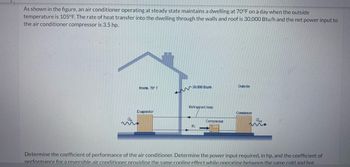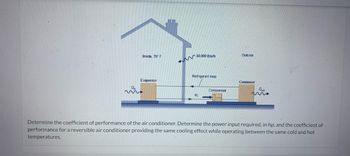
Elements Of Electromagnetics
7th Edition
ISBN: 9780190698614
Author: Sadiku, Matthew N. O.
Publisher: Oxford University Press
expand_more
expand_more
format_list_bulleted
Concept explainers
Question
9.5 thermodynamics

Transcribed Image Text:As shown in the figure, an air conditioner operating at steady state maintains a dwelling at 70°F on a day when the outside
temperature is 105°F. The rate of heat transfer into the dwelling through the walls and roof is 30,000 Btu/h and the net power input to
the air conditioner compressor is 3.5 hp.
Qin
m
Inside, 70° F
Evaporator
30.000 Btu/h
Refrigerant loop
We
Compressor
Outside
Condenser
Qou
m
Determine the coefficient of performance of the air conditioner. Determine the power input required, in hp, and the coefficient of
performance for a reversible air conditioner providing the same cooling effect while operating between the same cold and hot

Transcribed Image Text:Q
m
Inside, 70° F
Evaporator
30.000 Btu/h
Refrigerant loop
W₂
Compressor
Outside
Condenser
Qout
m
Determine the coefficient of performance of the air conditioner. Determine the power input required, in hp, and the coefficient of
performance for a reversible air conditioner providing the same cooling effect while operating between the same cold and hot
temperatures.
Expert Solution
This question has been solved!
Explore an expertly crafted, step-by-step solution for a thorough understanding of key concepts.
Step by stepSolved in 3 steps with 3 images

Knowledge Booster
Learn more about
Need a deep-dive on the concept behind this application? Look no further. Learn more about this topic, mechanical-engineering and related others by exploring similar questions and additional content below.Similar questions
- Chapter 6 discussed the Laws of Thermodynamics and their relation to energy and energy transfer. Energy transfers take place constantly in everyday activities. Think of two scenarios: cooking on a stove and driving. Explain how the second law of thermodynamics applies to these two scenarios. Using thermodynamic theory as a foundation, devise and comment on what you consider to be a good rationale for responsible consumerism.arrow_forward5.7. For the "standard atmosphere" shown in Fig. 5.5, perform the following calculations= (a) Derive the pressure-height relation for the troposphere. (b) Calculate the pressure at the troposphere-stratosphere boundary. (c) Derive the pressure-height relation for the stratosphere.arrow_forward9.16. One kind of thermodynamic diagram that is useful in engineering problems is the P–H diagram, in which the x-axis is molar enthalpy and the y-axis is pressure.(a) Several kinds of iso-lines can be drawn in such a diagram, including isotherms(constant temperature), isentrops (constant entropy), and isochores (constant molar volume). For each of these three cases, find expressions for the slope of these lines on a P–H diagram in terms of measurable properties.(b) Find expressions for these slopes for the ideal monatomic gas, in terms of T and P. Explain on physical grounds any unusual resultsarrow_forward
arrow_back_ios
arrow_forward_ios
Recommended textbooks for you
 Elements Of ElectromagneticsMechanical EngineeringISBN:9780190698614Author:Sadiku, Matthew N. O.Publisher:Oxford University Press
Elements Of ElectromagneticsMechanical EngineeringISBN:9780190698614Author:Sadiku, Matthew N. O.Publisher:Oxford University Press Mechanics of Materials (10th Edition)Mechanical EngineeringISBN:9780134319650Author:Russell C. HibbelerPublisher:PEARSON
Mechanics of Materials (10th Edition)Mechanical EngineeringISBN:9780134319650Author:Russell C. HibbelerPublisher:PEARSON Thermodynamics: An Engineering ApproachMechanical EngineeringISBN:9781259822674Author:Yunus A. Cengel Dr., Michael A. BolesPublisher:McGraw-Hill Education
Thermodynamics: An Engineering ApproachMechanical EngineeringISBN:9781259822674Author:Yunus A. Cengel Dr., Michael A. BolesPublisher:McGraw-Hill Education Control Systems EngineeringMechanical EngineeringISBN:9781118170519Author:Norman S. NisePublisher:WILEY
Control Systems EngineeringMechanical EngineeringISBN:9781118170519Author:Norman S. NisePublisher:WILEY Mechanics of Materials (MindTap Course List)Mechanical EngineeringISBN:9781337093347Author:Barry J. Goodno, James M. GerePublisher:Cengage Learning
Mechanics of Materials (MindTap Course List)Mechanical EngineeringISBN:9781337093347Author:Barry J. Goodno, James M. GerePublisher:Cengage Learning Engineering Mechanics: StaticsMechanical EngineeringISBN:9781118807330Author:James L. Meriam, L. G. Kraige, J. N. BoltonPublisher:WILEY
Engineering Mechanics: StaticsMechanical EngineeringISBN:9781118807330Author:James L. Meriam, L. G. Kraige, J. N. BoltonPublisher:WILEY

Elements Of Electromagnetics
Mechanical Engineering
ISBN:9780190698614
Author:Sadiku, Matthew N. O.
Publisher:Oxford University Press

Mechanics of Materials (10th Edition)
Mechanical Engineering
ISBN:9780134319650
Author:Russell C. Hibbeler
Publisher:PEARSON

Thermodynamics: An Engineering Approach
Mechanical Engineering
ISBN:9781259822674
Author:Yunus A. Cengel Dr., Michael A. Boles
Publisher:McGraw-Hill Education

Control Systems Engineering
Mechanical Engineering
ISBN:9781118170519
Author:Norman S. Nise
Publisher:WILEY

Mechanics of Materials (MindTap Course List)
Mechanical Engineering
ISBN:9781337093347
Author:Barry J. Goodno, James M. Gere
Publisher:Cengage Learning

Engineering Mechanics: Statics
Mechanical Engineering
ISBN:9781118807330
Author:James L. Meriam, L. G. Kraige, J. N. Bolton
Publisher:WILEY